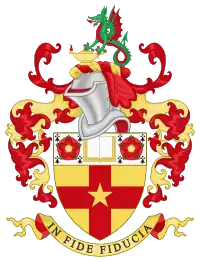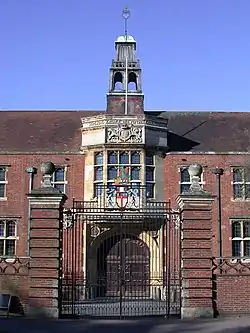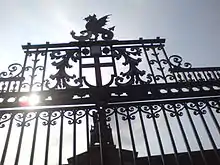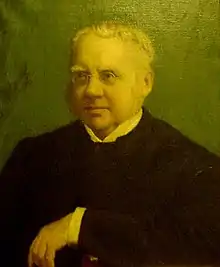The Leys School
The Leys School is a co-educational private school in Cambridge, England. It is a boarding and day school for about 574 pupils between the ages of eleven and eighteen, and the head is a member of the Headmasters' and Headmistresses' Conference.
| The Leys School, Cambridge | |
|---|---|
 | |
 | |
| Address | |
Cambridge , Cambridgeshire , CB2 7AD United Kingdom | |
| Coordinates | 52°11′48″N 0°07′13″E |
| Information | |
| Type | Public school Private boarding school |
| Motto | Latin: In Fide Fiducia (In Faith, Trust) |
| Religious affiliation(s) | Methodist |
| Established | 1875 |
| Department for Education URN | 110914 Tables |
| Headmaster | Martin Priestley |
| Gender | Co-educational |
| Age | 11 to 18 |
| Enrolment | 561 |
| Houses | See the Houses section |
| Publication | The Fortnightly |
| Alumni | Old Leysians |
| Rival | The Perse School |
| Website | www |
History
The nineteenth century saw the founding of a large number of new schools in Britain, especially by the churches—including the Wesleyan Methodist Church. Although there were already several leading schools that offered an education for the sons of ministers of the church, some Methodists were asking also for schools to be established for sons of lay church members. The Methodist Conference set up a committee to look at the possibility of starting a new school at either Oxford or Cambridge.[1]
Following several visits to Cambridge, they discovered that a twenty-acre (80,000 m2) site called "The Leys Estate" was being offered for sale. The estate was situated within easy reach of the city centre on the Trumpington Road, and it was close to the River Cam and to a number of Cambridge Colleges. The estate was acquired for the sum of £14,275 on 27 September 1872. The Reverend Doctor W. F. Moulton, who had been the secretary of the committee, was asked to become headmaster of the new school. The school opened on 16 February 1875 with sixteen boys, all from English Methodist families. After two years there were 100 pupils.[1]

During the twentieth century, The Leys grew significantly and by 1930 the number of pupils had reached 271. During World War II, the school temporarily moved to the Atholl Palace Hotel in Pitlochry, Scotland, returning to Cambridge in 1946.[2] During the Cold War, the school was designated the auxiliary headquarters to the Regional Seat of Government for Cambridge in time of war.[3] Today the majority of the pupils are boarders and since the admission of girls to the Sixth Form in the 1980s, the school has become fully co-educational. It now accepts pupils from the age of eleven,[4] rather than the age of thirteen as it was before.
Due to its location, the school is popular with Cambridge academics as a place to send their children, as well as a place to teach. For example, the physicist Stephen Hawking sent his son to the school[5] and gave a number of talks to its pupils.
Coat of Arms
 |
|
The red cross signifies the Christian foundation of the School whilst the open book and the lighted lamp are both symbols of learning.
The significance of the red rose is obscure: three such roses appear in the arms of the largest Cambridge college, Trinity, and Cambridge bears two silver roses in its arms. The most likely explanation, however, of the red roses is that several of the School's founders were from Lancashire and likely incorporated the Red Rose of Lancaster to symbolise their origins.
The stars of the original design may have symbolised aspiration or faith and hope in higher things. The wyvern, the crest used by the Wesley family, was presumably added to signify the association of The Leys School with the Wesleyan Methodist Church.[7]
Principles
Despite its Methodist traditions it has, for more than fifty years, been liberal on religion (although never secular). Many pupils received confirmation into the Church of England in the school chapel, and some others have had religious backgrounds from faiths other than the Christianity. Despite its religious liberalism, The Leys is predominantly a Christian school and they state openly that "The School’s Christian ethos lies at the heart of our education philosophy."
Pupils attend chapel services twice a week; a weekday service on a Friday afternoon plus Sunday services with the whole boarding community on a monthly basis with a weekly service with just their House on another specified day of the week. In addition, Holy Communion takes place once a term.
The school motto is "In Fide Fiducia" (Latin for "In Faith, Trust"), which is also the motto for its associated prep school, St Faith's School. The two schools make up The Leys and St Faith's Foundation. The school song is Rev. B. Hellier's Χαίρετε.
Academic results
In 2019, 52% of pupils scored A*-A for their A-Levels examination, whereas 83% scored A*-A for their GCSEs.[8]
Sport
The main sports played by boys during the three terms are:
- Rugby union (Autumn)
- Rowing
- Grass and AstroTurf Hockey (Spring)
- Cricket (Summer)
- Tennis
- Football
Girls play:
The school has a range of sports facilities spread across its 50-acre (200,000 m2) site. Other than the above-mentioned sports, the sports pitches include concrete, grass and AstroTurf tennis courts and a football pitch. The AstroTurf pitches are fully lit for night-time play. Indoor facilities include a fully equipped fitness centre, a sports hall for indoor sports such as badminton and netball, three squash courts and an aerobics studio. The school has a 25-meter heated indoor swimming pool and a rowing boathouse on the River Cam as well as several boats.
The Leys swims, competing against Eton (the only team to do so), and on a national level at the annual Bath Cup.
There is also a very active rowing club, with a newly refurbished boat house in position on the Cam, shared with King's, Churchill and Selwyn Colleges. Along with sailing (at St. Ives), this is a minority sport, counted among "pitch games" (the school's name for non-team sports). Other pitch games, include squash, badminton, tennis, athletics, karate, Eton Fives and golf.
Famous Leysian sportsmen include Neil White (Olympic hockey in 1948); Freddie Brown (Captain of England's cricket team); Geoff Windsor-Lewis (Wales Rugby, 1960); Paul Svehlik (England and Great Britain Hockey); and Neil Christie (Olympic rowing, 1976 and 1980).
Houses
There are 11 houses at The Leys,[9] the oldest being School House founded in 1878.[10]
- School is a thirteen to eighteen boys' boarding house with 30–35 boarders and 18–20 home boarders.[10]
- West is a thirteen to eighteen boys' boarding house with room for 45–48 boarders with 25–30 home boarders.
- North A is a boys' boarding house of 40–45 boarders and fifteen to twenty home boarders. North A House is located on the upper quad, opposite the chapel and adjacent to the Day Houses.
- Bisseker is part of the co-educational day house (known internally by its former name of North B House).
- Barker is a mixed day house with roughly 50 people.
- Barrett Typically around 50 people in each day house.
- Dale is a girls' boarding house with 38-42 boarders and 17–20 home boarders.
- Fen is a girls' thirteen to eighteen boarding house with 45–50 boarders and twenty to 25 home boarders.

- East is the Sixth Form boys' house with 27–30 boarders.
- Granta is the Sixth Form girls' house with 30 boarders and up to two home boarders.
- Moulton is the junior eleven to thirteen house for twenty to 25 boarders and 35–40 day pupils.
Goodbye, Mr. Chips
The setting for popular novel and play Goodbye, Mr. Chips is believed to have been based on The Leys where author James Hilton was a pupil (1915–1918). Hilton is reported to have said that the inspiration for the protagonist, Chips, came chiefly from W.H. Balgarnie, one of the masters at The Leys (1900–30) who was in charge of the Leys Fortnightly (where Hilton's first short stories and essays were published). Over the years old boys have written to Geoffery Houghton, a master of The Leys for a number of years and a historian of the school, confirming the links between Chips and Balgarnie. As with Mr. Chips, Balgarnie died at the school, at the age of 82, having been linked with the school for 51 years and living his last years in modest lodgings opposite the school. Again, like Mr. Chips, Balgarnie was a strict disciplinarian, but would also invite boys to visit him for tea and biscuits.
Hilton wrote, upon Balgarnie's death that "Balgarnie was, I suppose, the chief model for my story. When I read so many other stories about public school life, I am struck by the fact that I suffered no such purgatory as their authors apparently did, and much of this miracle was due to Balgarnie." Furthermore, the facial hair of one of the masters at The Leys earned him the nickname "Chops," a likely inspiration for Mr. Chips' name.
The Leys Memorial
The Memorial Chapel of The Leys is situated on the grounds of the school. It was built as a memorial to the first headmaster of The Leys, William Fiddian Moulton. Plans for the chapel, designed by architect Robert Curwen, were first presented to the school's second headmaster, W. T. A. Barber; he deemed the project an unnecessary luxury. Services were held in the school hall until 1904 when the governors approved the chapel's construction. The cost, including all furnishings, was estimated in 1925 to have been £39,000.
The foundation stone was laid at the marble West Door by Princess Helena of Waldeck and Pyrmont on 8 June 1905 and the chapel was consecrated on 27 October 1906. The building's design is Gothic, to complement the surrounding buildings. All visible woodwork is in oak. The roof comprises elaborately worked tussels and tracery work, somewhat after the lines of the famous roof of Westminster Hall. The floor is of alternating black and white marble. The chapel was designed to seat 350 boys, with the west balcony reserved for household staff.
In the First World War, 927 Leysians joined the armed services and 146 of them died. A memorial to the old Leysians who died, costing £48,000 and funded by donation, was on 6 June 1920 unveiled by the Duke of York. The memorial consists of four rows of names divided in the middle by a statue of an armoured St George, below which is written "To The Immortal Memory of Old Leysians Who Fell In The War Of 1914–1919", and in large block capitals the words "My Marks And Scars With Me To Be A Witness For Me That I Have Fought His Battles Who Now Will Be My Reward."
The chapel has fourteen windows; the Governors commissioned H. J. Salisbury to decorate them according to a unified theme.[clarification needed] The work was modelled on the windows of the King's College Chapel, Cambridge. Because the Leys is a Methodist school, the work was required to be simple and avoid complex symbolism. All but one of the windows depicts passages from the New Testament concerning the story of Christ; the large window over the main entrance instead shows ten Old Testament subjects forecasting the coming of the Messiah.
The Pulpit is made of oak and has a brass inscription reading "To the Glory of God and for the Preaching of His holy word this Pulpit was carved by Anne Hobson, Helen Mary Chubb, and George Hayter Chubb, and presented by the latter to The Leys, October, 1906."
The Leys Thistle
The Scottish community at the school set up the 'Leys Thistle' in October 1915 in order to unite Scottish families while they were away from Scotland. The 'Thistle' was created by Scottish members of North 'A'. Following the first meeting on Halloween 1915, the 'rush to join was tremendous'[11] and many applicants were said to have lied about Scottish heritage to get into the club, such was the demand. The publication of the society was called the 'Leys Thistle' and the first publication was in March 1917. The motto of the club is Nemo Me Impune Lacessit or 'no one touches me with impunity'.
The first publication of 'The Leys Thistle' states that the club had only three rules:
- 'That we, a brotherhood of fellows, united with each other to help and do anything can do to live up to the glorious traditions of Scotland.'
- 'To be an influence for good in the School: although we can't do much, still we can live decent and clean sportsmen's lives.'
- "To keep the society going: although the older fellows are leaving, still we look to younger generations to keep the flag flying.'
Notable alumni
Known as Old Leysians, they include:
Academia
- James Moulton (School House 1875-82)
- Sir John Clapham (North 'A' House, 1887–92): Historian
- Reginald Hine, Historian (West House 1898-1901)
- Louis Arnaud Reid (School House 1910-12): writer on aesthetics; foundation professor of the philosophy of education, London Institute of Education; Leys Board of Governors
- Eric A. Havelock (North 'B' House 1917-22): Classicist
- J. J. C. Smart (School House 1934-37): Scottish-Australian philosopher
- Christopher Smout (North 'A' House 1947-52): Current Historiographer Royal
- Simon Keynes (School House 1965-69): Elrington and Bosworth Professor of Anglo-Saxon at the University of Cambridge
- Professor James D. F. Calder (North 'A' House 1981-86): Orthopaedic Surgeon Fortius Clinic, Professor Imperial College London
- Professor Raphael Loewe (West House 1932-37) President of the Jewish Historical Society of England and professor of Jewish history
Business
- Tanaka Ginnosuke (North 'A' House 1890-93): Introduced rugby to Japan
- J. Arthur Rank, 1st Baron Rank of Sutton Scotney (North 'B' House, 1901–06): Industrialist and film producer; founder of the Rank Organisation
- Amschel Mayor James Rothschild (Fen House 1968-72): Businessman and member of the prominent Rothschild family
Politics/royalty
- John James Oddy (West House 1882-83): Conservative MP for Pudsey
- Walford Davis Green (North 'B' House 1883-88): Conservative MP for Wednesbury
- Sir Poonambalam Thyagarajan Rajan, (North 'B' House 1909-11) Chief Minister of Madras Presidency, British India, April 4 - August 24, 1946
- Peter Oliver, Baron Oliver of Aylmerton (School House, 1934–38): Judge, barrister and member of the House of Lords
- Richard Taylor (North 'B' House, 1947–53): Physician and independent MP for Wyre Forest
- King Hamad ibn Isa Al Khalifa, current King of Bahrain (West House 1965-66)
- Brent Symonette (North 'B' House 1968-73): Deputy Prime Minister and Minister of Foreign Affairs of The Bahamas
- King 'Aho'eitu 'Unuaki'otonga Tuku'aho (North 'B' House, 1973–77): Current King of Tonga
Science
- Francis Arthur Bainbridge (School House 1888-93): Physiologist; discoverer of the Bainbridge reflex
- Sir Henry Dale (School House, 1891–1894): Nobel Prize in Physiology or Medicine[Order of Merit]<See e.g. Who's Who 1968>
- Donald Woods Winnicott (North 'B' House, 1910–1914): Pediatrician and psychoanalyst
- Sir Donald Bailey (North 'B' House, 1916–1919): Civil Engineer who invented the Bailey bridge
- Neville Robinson (School House, 1938–1943): Physicist who achieved record low temperature
- Sir Andrew Wiles (North 'A' House, 1966–1970): Mathematician, proved Fermat's Last Theorem
Sport
- Richard Bell (North 'B' House 1889-92), cricketer
- G. LI. Lloyd: Wales (North 'B' House 1893-95) rugby union international who played against England 1900, 1901 and 1903[13]
- A. B. Flett (North 'B' House 1890-93): Scotland rugby union international in 1901–00[13]
- Tinsley Lindley (North 'B' & 'A' Houses 1884): Captained the England football team (1888, 1891)
- Frank Handford (North 'A' House 1900-01): English rugby union international who played on four occasions for his country and was part of the first official British and Irish Lions team that toured South Africa in 1910[13]
- Wilfrid Lowry (West House 1914-19): Rugby Union player for Birkenhead Park FC and England international in 1920[13]
- Charles Sutton (East House 1921-24), Anglo-Chilean cricketer
- Denys Witherington (West House 1933-38), cricketer
- Freddie Brown (North 'A' House 1925-29): Captained England cricket team fifteen times between 1949 and 1951
- Alan Skinner (School House 1926-31): first-class cricket cricketer for Derbyshire County Cricket Club
- David Skinner, (School House 1933-38) Captain of Derbyshire County Cricket Club
- Paul Svehlik (North 'B' House 1960-65) field hockey player who played 66 times for England and 31 times for Great Britain, including in the 1972 Munich Olympic Games .
- Justin Benson (East House 1981-84): first-class cricket cricketer for Leicestershire County Cricket Club and Ireland Captain
- Georgie Gent (formerly Stoop) (Fen House 2001-02): Tennis player
- Will Hooley (Barker House 2007-12): Rugby Union player for Northampton Saints, Exeter Chiefs, and Bedford Blues
- James Albery (West House 2009-14): Field Hockey player for England Hockey, Cambridge City Hockey Club, and Beeston Hockey Club
- Andy Laws (Bisseker House 2006-07, West House 2007-10) cricketer
Media
- Eric Whelpton (North 'B' House 1909-12): Author, basis for fictional character Lord Peter Wimsey
- James Hilton (School House 1915-18): Author whose works include Goodbye, Mr. Chips and Lost Horizon
- Ralph Izzard (West House 1924-28): Journalist, author, British Naval Intelligence Officer, inspiration for the Ian Fleming novel Casino Royale and one of the inspirations for its protagonist James Bond[14]
- Malcolm Lowry (West House, 1923–27): Author whose works include Under the Volcano.
- John Simon (critic): (School House 1938-39) Cultural critic for New York Magazine and other publications[15]
- Sir Alastair Burnet (School House, 1942–46): Journalist and broadcaster; editor of The Economist from 1965 to 1974; long-serving ITN newscaster
- J. G. Ballard (North 'B' House, 1946–49): Author whose works include Empire of the Sun
- Christopher Hitchens (North 'B' House, 1962–66): Journalist and religious and literary critic
- Peter Hitchens (West House, 1965–67): Journalist and polemicist
- Martin Bell (East House 1952-56) British UNICEF (UNICEF UK) Ambassador, a former broadcast war reporter and former independent politician
- Jack Saunders (Moulton House 2004-06, West House 2006-11) Radio 1 DJ
Other
- Richard Heffer (West House, 1959–64): Actor.
- Michael Latimer (East House, 1955–59): Actor.
- Michael Rennie (West House, 1924–26): Actor
- Sir Kenneth Hollings (North 'A' House 1932-35): Judge and Military Cross recipient.
- Sir John Royce, (West House 1958-63) British jurist.
- Col. Mark Cook (North B House 1956-61) Commander of the British Contingent of the UN Protection Force in Croatia 1992. Founder of charity Hope and Homes for Children.
- Col. George Howorth, O.B.E and Military Cross recipient.
- G. David Green (North A House 1962-69)
- David Moore Crook Spitfire pilot in the Battle of Britain and author.
Old Leysians have their own old boys' sports clubs including the "Old Leysian Football Club," which in its hey day (during the 1930s) was one of the leading Rugby clubs in the London area. There is also an active "Old Leysian Golfing Society" and "Old Leysian Cricket Club," which plays in the Cambridgeshire league.
Headmasters

- W. F. Moulton 1875–1898
- W.T.A. Barber 1898–1919
- H. Bisseker 1919–1934
- W.G. Humphrey 1934–1958
- W.A. Barker 1958–1975
- B.T. Bellis 1975–1986
- T.G. Beynon 1986–1990
- John C.A. Barrett 1990–2004
- Mark Slater 2004–2013
- Martin Priestley 2014–[16]
See also
References
- "StackPath". www.theleys.net. Archived from the original on 3 February 2022. Retrieved 28 October 2021.
- "60th Cambridge: The Leys School". Cambridge District Scout Archive. 4 December 2020. Archived from the original on 24 October 2021. Retrieved 28 October 2021.
- http://www.subbrit.org.uk/rsg/features/sfs/file5.htm Archived 2 November 2009 at the Wayback Machine The Leys School was designated a Regional Seat of Government in wartime
- Attain. "The Leys School". Attain. Archived from the original on 24 October 2021. Retrieved 28 October 2021.
- "The Leys School". Tatler. 16 October 2020. Archived from the original on 24 October 2021. Retrieved 28 October 2021.
- "Leys School". Heraldry of the World. Retrieved 25 February 2023.
- "Leys School". Heraldry of the World. Retrieved 25 February 2023.
- "The Leys School Guide: Fees, Rankings, Results And More". Britannia StudyLink Malaysia: UK Study Expert. 7 September 2020. Archived from the original on 2 December 2020. Retrieved 8 January 2021.
- "The Leys School". Archived from the original on 24 October 2021. Retrieved 24 October 2021.
- "StackPath". www.theleys.net. Archived from the original on 3 February 2022. Retrieved 28 October 2021.
- "The Leys Thistle, March 1917" (PDF). Archived (PDF) from the original on 1 October 2018. Retrieved 27 November 2018.
- See
- Football: The Rugby Union Game — Page 30 by Francis Marshall, Leonard R. Tosswill — Football — 1925
- The Life of Ian Fleming, John Pearson, p. 194-195, (Jonathan Cape, London, 1966) ISBN 978-1-85410-898-2
- McFadden, Robert D. (25 November 2019). "John Simon, Wide-Ranging Critic With a Cutting Pen, Dies at 94". The New York Times. ISSN 0362-4331. Archived from the original on 26 November 2019. Retrieved 28 October 2021.
- Read, Julian (25 February 2014). "Meet Martin Priestley, headmaster of The Leys School". Great British Life. Archived from the original on 24 October 2021. Retrieved 28 October 2021.
Further reading
- Baker, Derek (1975). Partnership in Excellence: A Late-Victorian Educational Venture: The Leys School, Cambridge, 1875-1975. Cambridge: The Governors of The Leys School.
- Houghton, Geoff and Pat (2000). Well-regulated Minds and Improper Moments: A History of The Leys School. Cambridge: The Governors of The Leys School. ISBN 0-9501721-8-9.